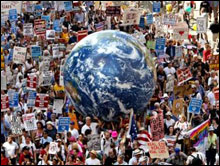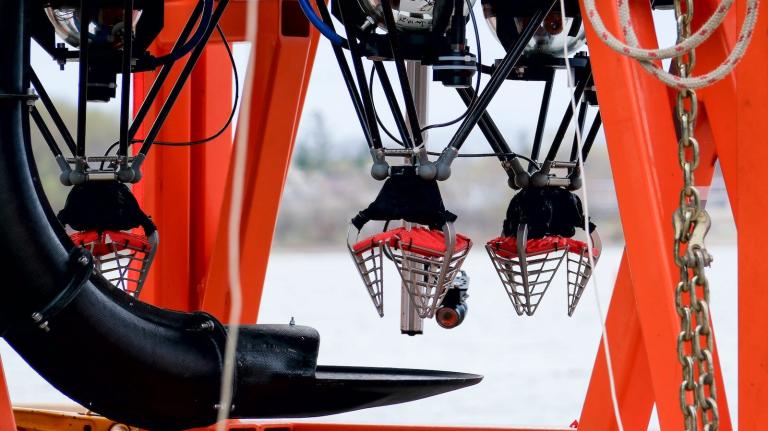David Epstein lives in New York and works as an intern for the New York Daily News.

Tuesday, 31 Aug 2004
NEW YORK, N.Y.
Inside Madison Square Garden, the Republican National Convention has barely gotten underway. But out in the streets, the climate has been steadily warming.
Not that climate change, or for that matter any serious environmental issue, has had a high profile inside or outside the convention. The most telling environmental symbol so far in New York appeared during Sunday’s massive protest, organized by the umbrella group United for Peace and Justice, where about 100 Sierra Club members clad in neon green barely speckled a mass of an estimated 500,000 people (according to The New York Times) — their concentration a scarcely detectable 200 parts per million.

The planet made an appearance at this anti-Bush protest, even if Greenpeace didn’t.
Photo: Indymedia.org
As Amanda Griscom noted in last week’s Muckraker column, “Methinks They Doth Not Protest at All,” nearly every major environmental group decided to stay home this week, seeing little to gain from protesting the RNC. So why did the Sierra Club show up at all? Sierra Club President Larry Fahn says the group came to demonstrate against “all the stuff that is named wrong — Clear Skies, the Healthy Forests initiative, all those fantastically Orwellian policies.” Fahn also considers the convention a personal affront to the New York community. “There are still people suffering from government deceptions about Ground Zero air,” he said. “It’s disgraceful to have the convention storm in here.” Finally, he says, “We’re just trying to spread the word that this is the most environmentally destructive administration in history.”
Or, as Martha Marks, head of the New Mexico-based Republicans for Environmental Protection, has said, “Bush makes Ronald Reagan look like John Muir.”
While environmental protesters leave their tiny footprint out in the street, another group is trying to ensure that the convention itself will not leave an elephant-sized footprint on New York. The nonpartisan, nonprofit Coalition for Environmentally Responsible Conventions (CERC) has not been marching down Seventh Avenue in gorilla suits, like the five-person “Gorillas Against Rainforest Guerrillas,” but they have been laboring behind the scenes to ensure that the Republican National Convention is a green gathering. (They played a similar role at the Democratic National Convention).
CERC arranged for eight General Motors hybrid buses to whisk delegates around at five miles per gallon, rather than the normal three miles per gallon of city buses. GM is hoping that the convention will serve as an East Coast showcase for the hybrid buses. “There are 235 hybrids in Seattle already that save 750,000 gallons of oil a year,” said Kevin Rodgers, hybrids strategic analyst for GM. “I’m from Indianapolis and I’ve had an easier time getting through traffic in New York with the mass transportation and the bus lanes. We’re still so dependent on our car infrastructure in the rest of the country. Hopefully the delegates will take the word back home with them.”
CERC convinced the U.S. EPA to put notices in the buses explaining New York’s three-minute idling law. That law was passed in 1971 but didn’t really come under public scrutiny until a 2003 city survey found that one-third of all New York buses idled longer than three minutes, and that some of the nation’s highest asthma rates were found near New York bus depots.
Additionally, CERC has assured that about 1 million sheets of paper will be saved by setting up a local computer network that allows for paperless communication at the convention media center, the Farley Building near Madison Square Garden.
ConEdison Solutions is pitching in to help offset the convention’s environmental footprint by purchasing and donating 474 megawatt hours of wind energy from New York’s Fenner Wind Farm, an amount equal to the estimated energy consumption of Madison Square Garden during the convention.*
But while CERC tries to make the GOP convention green, it can do little to offset the situation out in the streets, where scads of fliers have littered the city over the past five days. No estimate of tonnage has been made yet, but a protester with only one flier was a rarity at Sunday’s march, and Union Square has been continually draped in paper since Thursday. On 33rd Street, tiny whirlwinds of colorful anti-Bush fliers spun down the blocked-off and deserted roads like tumbleweeds down Main Street in Tombstone. Wilting posters and a litter of water bottles and political stickers cluttered the rock-strewn shore of the Hudson River near 125th Street in Harlem.
The ultimate absurdity of the RNC circus — a floor show and street demonstration calculated to catch the media’s eye while frustrating average New Yorkers — might best be characterized by last Thursday’s bike rally. A monthly event known as Critical Mass and organized in part by the environmental group Time’s Up!, the rally had promised to be the biggest eco-showing during the protests, but in the end had only a dash of environmental flavor. It was unclear how many of the 5,000 bikers that shut down the streets without a permit knew that Time’s Up! is a group dedicated to alternate means of transportation. “I don’t have a particular environmental cause,” said Billy Scuteri, 35, as he readied his bike at Union Square. “I’m just pissed I had to close my pizza shop on [33rd Street] for the convention.”
Bikers streamed south down Broadway before turning uptown and wreaking traffic havoc in Times Square. At each intersection, several bikers positioned themselves in front of side streets to block cars while other riders passed.
“Come on, I’m going to lose my customer!” yelled taxi driver Benn Samm through the discordant clanging of hundreds of bike bells.
“Hey, honey, I’m actually holding up a car right now!” a biker bragged into his cell phone. The question “Why?” must have been asked on the other end. “We’re doing a bike ride!” the biker replied with childish glee.
“Please, please move,” Samm pleaded. But the biker blocking his car was too busy “sticking it to the man” in Washington, as he put it, to care that he was actually sticking it to a $20,000 per-year cabbie, and forcing him to idle for more than three minutes to boot.
As a New Yorker, I sympathize with Samm just trying to get through the day. With all the littering and traffic-blocking, I can understand why many environmental groups decided to stay home; if they showed up, they would run the risk of being identified with the radical litterbugs. As Aimee Christensen told Griscom in Muckraker, “We don’t see it in our interest to be in New York.”
But environmental groups must balance their own interests against the dangers of remaining silent. As it is, they have left the GOP to address the environment on its own time — and so far, it has not found a minute.
– – – – – – – – –
This piece reflects the opinion of its author and should not be taken to constitute an official endorsement by Grist Magazine, its staff, its board members, their massage therapists, or their personal trainers.
*[Correction, 07 Sep 2004: This article originally stated that the Coalition for Environmentally Responsible Conventions purchased the electricity from the Fenner Wind Farm. In fact, it was ConEdison Solutions that bought the wind power.]


